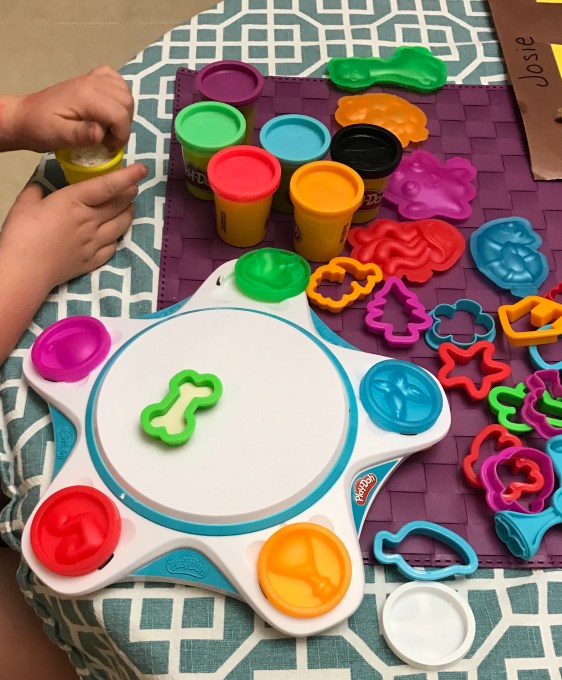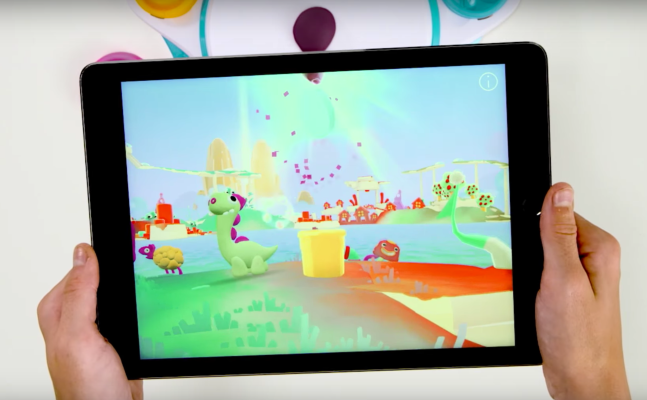Play-Doh has come to the iPad. With the newly launched toy set for kids, Play-Doh Touch Shape to Life Studio, Hasbro has made a solid attempt at bringing the joy of Play-Doh to digital through an iOS app that brings kids’ creations to life. But the combination of physical play and digital is not a skill set that’s easily mastered even by top kids’ brands — just ask Disney Infinity.
And while Play-Doh itself holds up as the engaging and fun toy it’s been for decades, the Play-Doh Touch app fails to amuse after only a few minutes.
On paper, Play-Doh Touch sounds intriguing.
The idea is that kids can use Play-Doh to create as always – using scissors, stamps and molds – then place their resulting creations on a white surface where they’re scanned and ported into a digital world where they’ll actually come to life. That means you can create a cute green dinosaur, for example, then see him begin to hop around on the screen.
Clever, right?
You can try Play-Doh Touch on its own just by downloading the app from the App Store, then using the Play-Doh you already have around the house to test it out.
However, the $40 Play-Doh Touch Shape to Life Studio offers everything you need to get started, including seven cans of the modeling compound, 10 character and action stamps, plus tools and 15 cutters. There’s also the “Shape to Life Studio” itself, which is really just a white plastic platform where you place kids’ creations before snapping your photo.
[gallery ids="1418436,1418437,1418438,1418435"]
Though the kit has a lot of pieces, the choice of character stamps seem a bit odd. Instead of commonly popular animals like cats, puppies or birds, you’re given things like a jellyfish, three-eyed ghost, turtle, and something I believe is a worm, though it could be a snail. The rest of the accessories are focused on world-building: trees, a cactus, leaves, clouds, a bone (for T-Rex, ostensibly, though my kid was sad to find there was no dog), etc.
Of course, you can turn any ol’ misshapen blob (see pictures below) into a digital character using the Play-Doh Touch app, as it doesn’t criticize your tot’s artistic capabilities by failing to scan their weird designs if they don’t match up with one of the included molds.
The app, however, was hard to use at the kitchen table because you have to hold the camera high above the creation, and little arms can only reach so far. Parental involvement may be needed. (Plus, these jars don’t open easily, I must note.)
 There’s some initial fun in seeing whatever funny creature your kid has shaped appear on the iPad’s screen and animate, and the gameplay is easy enough for even little ones to understand.
There’s some initial fun in seeing whatever funny creature your kid has shaped appear on the iPad’s screen and animate, and the gameplay is easy enough for even little ones to understand.
But Play-Doh fails to create a compelling world after the whizz-bang glee of its digital trickery wears off.
Most kids today have a host of extremely well-built apps at their disposal, and are fairly adept gamers in general.
Even my kid – who’s still more into Toca Boca’s digital “toys” more so than Minecraft – became almost immediately bored with Play-Doh’s gaming experience.
After not even five minutes, I kid you not, her comment was, I quote: “Mommy, this is boring.”
It appears she quickly figured out there was no advanced gaming technique needed to move through the world and jump over the obstacles.
“All you have to do is hold the side,” she explained, showing me how she continually pressed on the screen to keep the character moving forward.
[gallery ids="1418443,1418442,1418441"]
Above: some of the more boring screens in the app
In other words, the game itself was not challenging. And, beyond the fact that it was something you created jumping around on the screen, it wasn’t really interesting either. There are no big storylines to follow, character dialog, things to unlock, puzzles, or anything else that would make the game fun.
[gallery ids="1418449,1418448,1418447"]
At best, the app might interest toddlers – but Play-Doh has broader appeal, and should have tried harder on building a great game, too. As it stands, it’s pretty clear all the development effort was focused on the creation-to-life aspect.
For $40, Play-Doh Touch Shape to Life Studio feels like too much to pay, considering the limited experience the digital component currently offers. Today, you can buy the best part of Play-Doh Touch’s kit for a lot less: a 10-pack of full-sized Play-Doh jars is under $10 and a 24-piece setting of models and molds is running around $14 on Amazon.
If you still want to give Play-Doh Touch’s app a go, it’s a free download on iTunes. You can buy the other in-app worlds for an additional $1.99 each, if you choose. The app works on both iPads and iPhones.
